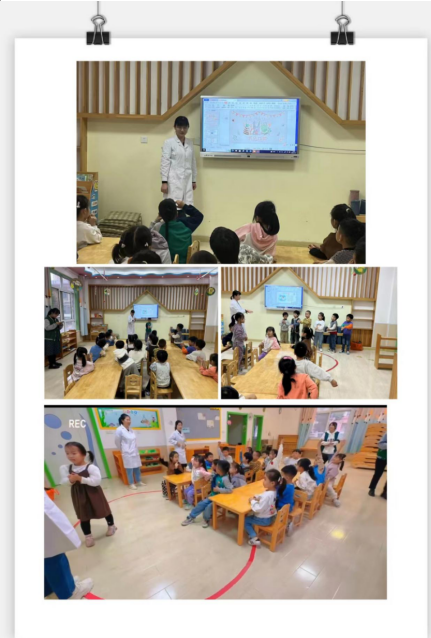- Date:2023-11-03
- Click:5180Times
Hand, foot and mouth disease is a common infectious disease in childhood, why is it easy to be popular among children. First of all, the resistance of children is much lower than that of adults, in addition, children are easy to gather together to play, hand hygiene is worse than that of adults, so it is easy to be infected, in order to reduce the infection rate of hand, foot and mouth disease and improve the awareness of children's prevention and control, the nursing team composed of three nurse practitioners, namely, Liu Yuanyuan, Li Lixia, and Ding Jieli, went into the Hanlin kindergarten on November 3, 2023, to conduct a scientific and popular education on the knowledge of hand, foot and mouth disease for the children. Hand, foot and mouth disease related knowledge popularization education for children.
Nurse Ding Jieli explained to the kindergarten children the relevant knowledge of hand, foot and mouth disease: hand, foot and mouth disease is an infectious disease caused by enteroviruses, triggered by hand, foot and mouth disease of more than 20 kinds of enteroviruses occurring mostly in children under 5 years of age, the manifestations of mouth pain, anorexia, low-grade fever, small herpes or ulcers appear on the hands, feet, mouth and other parts of the body, the majority of children with about a week of spontaneous healing, and a small number of children can be caused by myocarditis, pulmonary edema, sterile meningitis, encephalitis, and other complications. A small number of children can cause myocarditis, pulmonary edema, aseptic meningoencephalitis and other complications. Individual children with severe disease develop rapidly, resulting in death. At present, there is a lack of effective therapeutic drugs, mainly symptomatic treatment.
Symptoms: maculopapular rash on hands, feet, buttocks, arms, legs, later turning into herpes, herpes may be surrounded by an inflammatory red halo, with less fluid in the blisters. The hands and feet are more, the back of the palm are there. The number of rashes is as few as a few dozen. No traces remain after subsiding, no pigmentation. Acute onset, fever, mouth pain, anorexia, oral mucosa appear scattered herpes or ulcers, located in the tongue, buccal mucosa and hard forehead and so on place is more, can also spread to the soft palate, gums, tonsils and pharynx.
HFMD can be transmitted to healthy babies in many ways, but mainly through close contact between people. For example, healthy babies may get sick through contact with hands, towels, dental cups, toys, cutlery, bedding and underwear contaminated with saliva, herpes fluid and feces of HFMD patients.
- The virus in the throat secretions and saliva of affected children can also be spread through the air (droplets).
Prevention - Drinking or eating contaminated water, food, etc. can also cause transmission.
Wash children's hands with soap or hand sanitizer before and after meals and after going out, do not let children drink raw water or eat raw or cold food, and avoid contact with sick children.
-Bottles and nipples used by infants and young children should be washed before and after use.
-During the epidemic period, children should not be taken to public places where crowds gather and air circulation is poor. Attention should be paid to maintaining environmental hygiene in the home, ventilating the living room frequently, and drying clothes and quilts diligently.
-Children should go to a medical institution in time if they have symptoms. Children should not come into contact with other children. Parents should dry or disinfect children's clothes and disinfect children's feces in a timely manner; children with mild cases do not need to be hospitalized, and it is better for them to stay at home for treatment and rest in order to reduce cross-infection.
-Daily cleaning and disinfection of toys, personal hygiene equipment, tableware and other items.
Ms. Liu Yuanyuan and Ms. Li Lixia instructed the children on the seven-step cleansing technique.

Remember the seven-step hand washing mnemonic: internal, external, pinch, bow, large, standing, wrist.
1. Internal: Wash the palms of the hands
Wash the palms of your hands with your palms facing each other and your fingers together, then rub them together.
2. Outside: Wash the back side of the finger joints.
Wash the palm against the back of the hand, rubbing each other along the finger joints and exchanging hands.
3. Clip: Wash the palm side finger joints.
Cross your hands and rub each other along the finger joints with your palms facing each other.
4. Bow: Wash the back of the fingers
Bend the joints of the fingers, put the backs of the fingers in the palm of the other hand with a half fist and rub them together, exchanging hands.
5. Big: Thumb Wash
Hold your thumb in one hand and rub it with both hands.
6. Stand: Wash the fingertips
Bend the finger joints of one hand and bring the fingertips together, then place them in the palm of the other hand and rotate and rub them together, exchanging hands.
7. Wrist: Wash Wrist
Hold one hand and rub the other hand at the wrist, exchange hands. Children listen to the serious and fascinated extremely with us to get the activities, can master the basic steps of hand washing.
The 7-step handwashing method works by thoroughly cleaning the hands and effectively killing most bacteria and viruses, thus reducing the risk of spreading diseases. It also prevents cross infection and protects your health and the health of others. Proper hand washing prevents the spread of respiratory and intestinal infections, skin infections, and a number of other communicable diseases. In addition, hand washing removes dirt and grease from the hands, keeping them clean and comfortable.
Measures to prevent HFMD are mainly in the following aspects: the first aspect is the need to pay attention to diligent hand washing, hygiene, and try to cut off the transmission of HFMD. The second aspect is to pay attention to strengthen the nutritional intake, improve immunity and reduce the risk of infection. The third aspect is to pay attention to avoid close contact with children with HFMD, in order to prevent the possibility of infection. The fourth aspect is to pay attention to early vaccination.

(Contributed by: Liu Yuanyuan Ding Jieli, Department of Emergency Medicine, Headquarter)



 鲁ICP备11009722号-4
鲁ICP备11009722号-4 